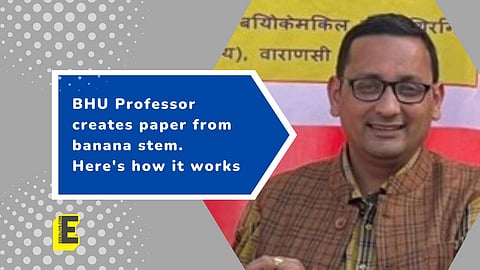

Dr Vishal Mishra, Assistant Professor in the School of Biochemical Engineering, IIT (BHU) Varanasi, has concluded a workshop at Raipur village in Bithauli, near Lucknow, to train farmers to turn agricultural and kitchen waste into liquid organic fertiliser and paper.
According to a report by IANS, in a training session on Saturday, February 11, Dr Mishra demonstrated the conversion of kitchen and agro-waste like fruit and vegetable peels into liquid organic fertiliser and paper. He said that this would uplift the socio-economic status of villagers and farmers in the pastoral parts of the country and boost grassroot innovations, start-ups and entrepreneurship among the youth of villages.
Speaking to IANS, the assistant professor, explained how paper could be produced from banana stem fibre. "The fibre from the banana is removed and washed with sodium hydroxide in order to eliminate natural resins that can decrease the strength and durability of the paper. The washed fibre is used to form a stronger fibre (agricultural fibre). Then, pulp is made that is used in the production of paper," he explained.
Read Also : 'We've had petrol bombs thrown at us,' IIT-BHU students beg for more security on campus
Banana stem juice is extracted in order to get the fibre from the pseudostem of the banana. Dr Vishal Mishra said that making paper from banana stem fibre is a process that involves several steps, including harvesting, cleaning, cutting, cooking, rinsing and beating the fibre, followed by the final step of forming and drying the paper. Explaining the process, he said that the first step involves harvesting the banana stems, which are the long, fibrous stalks that hold up the bunch of bananas. The stems should be harvested when they are mature and fully developed, as the fibres are at their strongest and most abundant at this stage.
The harvested banana stems should be cleaned of any dirt or debris, as this can interfere with the quality of the fibre. The cleaned stems should then be cut into small pieces and the outer layer removed, exposing the fibre inside. The cut fibre is then cooked in a solution of soda ash for several hours. This process helps to break down the fibre and makes it easier to separate them from the stem.
After cooking, the fibres are rinsed in clean water to remove any residual soda ash. The fibres are beaten in a machine called a Hollander beater to separate them from one another and make them more pliable. The beaten fibre is then formed into sheets of paper using a mould and deckle. The mould and deckle determine the size and shape of the final sheets of paper.
The thus formed paper sheets are then dried by pressing out any remaining water and hanging them up to air dry completely. This method produces high-quality paper that is durable, absorbent and environment-friendly, making it a great alternative to traditional paper made from wood-pulp fibre. Dr Vishal Mishra also said that bio fertiliser could be prepared by using banana peel and used tea residue with anaerobic respiration packed in a bottle for 15 days.
